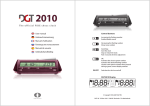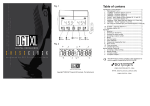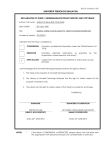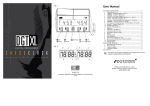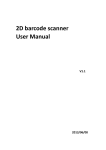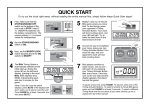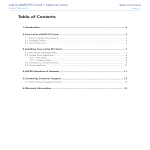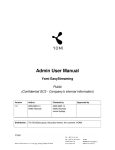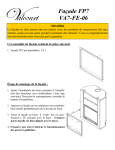Download INSTRUCTIONS FOR USE - MetroWest Chess Club
Transcript
INSTRUCTIONS FOR USE The Official Chess Clock DGT Projects, B.V. Digital Game Timer User Manual Congratulations for choosing the DGT Projects Digital Game Timer. We hope and expect that it will be to your entire satisfaction and will give you many years of pleasure. Albert Vasse Ben Bulsink Paul Arentz DGT Projects B.V. Postbus 1295 7500 BG Enschede Nederland © Copyright 1994 DGT Projects B.V., Enschede, Nederland 1. Batteries The Digital Game Timer (DGT) requires 4 AA (penlight) batteries. We recommend alkaline batteries, on which it will run for 5000 hours. To insert the batteries, remove the screw cover from the battery compartment on the bottom of the timer. After the batteries have been inserted, wait four seconds before switching on the timer. NOTE: If you do not plan to use your timer for a long period, we recommend that you remove its batteries. If "BAT" appears on the timer display, the batteries are nearly discharged and should be replaced as soon as possible. When this message first appears, the batteries still contain enough energy to allow the current game to be completed. NOTE: In case of a malfunction, first remove then reinsert the batteries. If the problem still occurs, contact your retailer. 2. Switching on the Digital Game Timer Switch the time on and off with the On/Off switch on the bottom of the timer. 3. Choosing an option number Your timer includes many different timing methods. You set the timing method you want by selecting an option numbers on the timer's display. When you switch on the timer, the display shows the option number that was last selected. (If batteries have been changed, the display is reset to option 01.) Press the +1 button to step through the 32 options. After number 32, the display returns to 01. To find the option you wish, see the list of option numbers on the bottom of the timer. (For example, option 01 corresponds with number 1: Rapid, Blitz: 5 minutes.) For details on each option, see this manual's TIMING METHODS section. 4. Activating the option number When the option number you want appears on the display, activated it by pressing the OK button. The display then shows the default starting time for that option. You can now begin your game. NOTE: If you want to change the setting time for your seleceted option, see Section 9, Manual settings. 5. Starting a game When you have selected your option number, start the timer by pressing the Start/Stop button. NOTE: Before the clock is started it is necessary to ensure that the lever is raised on the side of the player who is the first to play. This is particularly important for the FIDE and Fischer methods for which the clock "knows" from the starting position of the lever which player plays white and which black. 6. Temporarily stopping the timer During the course of a game, you can temporarily stop the timer by pressing the Start/stop button. Restart the timer by pressing the start/stop button again. 7. Checking the option number during a game During a game, you can check the selected option number without interrupting the countdown. To do this, press the OK button. 8. Changing the time duing a game During a game, you can change the time that is currently displayed. Hold the start/stop button for three seconds, until the display flashes. The display first shows the time for the left-hand player (if it wasn't already showing). To change the flashing value, press the +1 button. After the highest digit (9 or 5) has been reached, press +1 again to return to zero. As each desired digit appears, press the OK button. This causes the next digit to flash. When you press OK to change (or accept) the last digit of the left-hand player's time, the right-hand player's time appears, which you can change similarly. To accept a player's time without changing it, simply press OK for each flashing digit. The sequence of digits is: 1. Hours 2. Tens of minutes 3. Minutes 4. Tens of seconds 5. Seconds When you have changed or accepted both players' times, and the last selected diigit is no longer flashing, press Start/stop to restart the timer. It resumes the countdown based on the corrected times. The countdown is suspended while you change the time(s); therefore, if the top lever is moved during a time-change, it does not affect either player's current time. NOTE: In the Fischer Tournament option, you can also change the number of moves played after you change (or accept) the time(s). The number displayed is the number of moves played by Black. Overtime method (game of go): By changing the times during a game, you can play according to the so-called Overtime method (Canadian byo-yomi) used in the game of go. If you make a time change during a game played with the FIDE or Go with byo-yomi timing methods, and your change is made while the game is in the phase of added time for each move, then the timing always reverts to the main timing phase. If you are using the FIDE method and you want to continue the game in the phase in which time is added per move, the only way to do so is by switching to the FisherRapid option, and manually entering each player's new time, as follows: 1. Make a note of each player's time. 2. Press On/Off to return to option selection mode. 3. Select option number 23. 4. Enter the players' times and the bonus per move, then continue the game. 9. Manual settings Each option (timing method) has default settings. However, you can manually change these settings as you wish. 1. Use the +1 button to select the option number you want to use. 2. Press OK to activate the option. The time for the left-hand player appears. 3. The display shows the last time that was used for the option. The first digit flashes to indicate that the time can be changed. NOTE: If you want to use the times without changing them, hold the OK button until the display stops flashing. When manual set or time correction is chosen, it is possible to skip digit-by-digit entry by pressing Start/Stop when the first digit is flashing. 4. Change the currently flashing digit with the +1 button. When the desired digit appears, press OK. This causes the next digit to start flashing. If you don't want to change a digit, just press OK. 5. When you have finished entering the left-hand player's time, the right-hand player's time appears. Enter that time the same way. NOTE: The maximum displayable time is 9:59.59. Do not exceed this time, or the timer will no longer function correctly. When you have entered (or accepted) the players' times, you can enter extra settings for the option, as follows: Option # Name Settings 3 Rapid/Blitz (No extra settings) 5 1 Period + Guillotine 1. Guillotine period for both players 7 2. Periods + Guillotine 1. Second period for both players 2. Guillotine period for both players 9 Repeat second period 1. Repeat periods for both players 14 FIDE Rapid 1. Added time per move (left-hand player) 2. Added time per move (right-hand player) 17 FIDE Tournament 1. Second period for both players 2. Added time for both players 20 Bronstein 1. Free time per move (left-hand player) 2. Free time per move (right-hand player) 23 FischerRapid 1. Extra time per move (left-hand player) 2. Extra time per move (right-hand player) 25 Fischer Tournament 1. Extra time per move for both players 2. Number of moves in the 1st period 3. Second period for both players 4. Number of moves in the 2nd period 5. Third period for both players 6. Number of moves in the 3rd period 7. Fourth period for both players 28 Go with byo-yomi 1. Byo-yomi time per move for both players 2. Number of byo-yomi periods 30 Hourglass (No extra settings) 32 Gong Elapsed time before gong sounds 10. Skipping manual settings or time changes Sometimes you may begin to make a manual time setting, or begin to change a time during a game, then change your mind. Simply press Start/Stop button when the first digit is flashing. 11. Display symbols In addition to the digits, the timer's display shows the following symbols: BAT Indicates that the batteries must be changed. Ù (triangle) Indicates that a point in the game has been reached when time-per-move is added. This occurs in Bronstein and Fischer options (from the start of the game) and in FIDE and byo-yomi options (after a traditional starting period has elapsed). – The interim flag; indicates that this player is the first to to go on to the following time period. – (flashing) The ultimate flag; indicates a player who has run out of time. : (colon) Indicates that the times displayed are in hours and minutes (for instance 1:45). . (period) Indicates that the times displayed are in minutes and seconds (for instance 17.22). NOTE: 12. Time display For times over 20 minutes, the Digital Game Timer displays hours and minutes. For times under 20 minutes, the Digital Game Timer displays minutes and seconds. 13. Malfunctioning If your timer doesn't operate correctly, first try removing and reinserting the batteries. (Be sure the batteries are not discharged; use a battery tester if necessary.) If the problem persists, contact your retailer. TIMING METHODS The Digital Game Timer offers 12 different methods for timing games between two players. Whilst several methods are well known, others may be less familiar. Several of these methods have been in use for a long time, others are the result of the possibilities offered by modern electronics. Every method has its own charm and has an influence on the manner in which a sport is experienced. The traditional "quickie" of 5 minutes per person is different from 3 minutes using Bronstein or Fischer in which every move attracts an extra 3 seconds of thinking time, although the total thinking time for a game is hardly any different. We recommend players to experiment with the various methods which the Digital Game Timer offers. It can add an extra dimension to a favorite sport. 1. Rapid and Blitz. (Options 1, 2 and 3) The simplest way to indicate time. Both players are allocated one period in which they must make all moves. 2. 1 Period + Guillotine (Options 4 and 5) The first period is used to play a predetermined number of moves. The second period, the Guillotine, is used to complete the game. 1 Period + Guillotine is similar to “Rapid and Blitz” but with a slower start. 3. 2 Periods + Guillotine (Options 6 and 7) For an even quieter start it is possible to play a game with two periods before the Guillotine. 4. Repeated 2nd time periode (Options 8 and 9) A quiet end to a game also has its advantages. The simple traditional clock gives the players repeated one-hour periods in which to complete a subsequent number of moves. A consequence of this method, which has been the standard in the game of chess for more than 50 years, is that the game cannot always be decided in one session. The increasing playing strength of chess computers and the information available in end-game databases is having an increasingly greater influence on the result of adjourned games. The trustworthiness of the strength measurement between players has come increasingly under pressure. Proposals have come from various sources, for methods of ending a game in one session without having to fall back on the Guillotine as a means of determining a game, since this could have an undesirable influence on the end result. The FIDE, Bronstein and Fischer provide a solution to this dilemma by providing the players with a predetermined amount of thinking time for each move. 5. FIDE Rapid (Options 10, 11, 12, 13 and 14) The FIDE-rapid method begins a game with a traditional period during which a previously determined number of moves must be completed. When this period is ended a triangle appears in the display. From that moment the player gets extra time for each subsequent move. The thinking time which remains unused at the end of a move is preserved to the following move. By completing moves in a time which is shorter than the extra time per move, a player can build up the thinking time available for subsequent moves. Note: The Digital Game Timer remembers, through the operation of the lever at the start of a game, which player is playing white. This has consequences for the moment when a player exceeds the available thinking time for the first time. If black is the first to exceed the allotted time for the first period then white receives a double bonus. This is also important in the FIDE-tournament and in both Fischer options. 6. FIDE Tournament (Options 15, 16 and 17) In this method two periods of time are alloted before extra time per move is available. 7. Bronstein (Options 18, 19 and 20) The oldest proposal from the chess world for a solution to the problem of limited thinking time came from IGM David Bronstein. His method applies from the first move, so that the triangle appears immediately in the display. The principal thinking time is reduced by delay. Before the principal thinking time is reduced the player has a fixed amount of time to complete a move. It is not possible to increase the thinking time by playing more quickly as it is in the FIDE and Fischer methods. 8. Fischer Rapid (Options 21, 22 and 23) This method also applies from the first move. The difference between this and the Bronstein method is that it is possible to obtain increased thinking time by completing a move in a time which is shorter than the extra time allowed. Always ensure that the lever is in the correct position before a game begins. 9. Fischer Tournament (Options 24 and 25) The Fischer Tournament method is the most complex in the way thinking time is regulated. In addition to the extra time available per move, the player is also allotated an extra amount of principal thinking time after a pre-determined number of moves has been completed. For this option a move counter is available. This counts the number of completed moves (that is: the sum total of the moves played by both white and black). The allocation of new principal thinking time occurs only at the appropriate moment if the DGT is carefully operated. 10a. Go with byo-yomi (Options 26, 27 and 28) From its very nature the game of go lends itself naturally to allowing players extra time to complete a game. Traditionally, the byo-yomi method is used for this. Byo-yomi gives the player who has used up his thinking time a fixed amount of time for each subsequent move. In normal games of Go the principal thinking time allowed is 1 ½ to 2 hours, usually combined with a byo-yomi of 20 to 30 seconds. After the principal thinking time has been used the clock jumps to byoyomi time. Each time a player completes a move the clock jumps back. If the player has not completed the move before the clock reaches 0 a flag appears in the display. For top matches the principal thinking time is 9 hours which is followed by 5 byo-yomi periods of 1 minute each. At the end of the 9-hour period the clock jumps to 5 minutes. If the player completes a move before a time of 4 minutes is reached the clock jumps back to 5 minutes. If he completes a move after the 4-minute period has been exceeded, the clock reverts to 4 minutes. The clock thus reverts each time to the beginning of the current byo-yomi period. 10b. "Overtime", Canadian byo-yomi In order to use the original byo-yomi method with traditional clocks it was always necessary to have a time referee with a stopwatch. This regularly resulted in personnel problems. Therefore, in recent years the game has often been played using a compromise solution in which each player is given 5 minutes new thinking time to complete a fixed number of moves, usually 10 or 15. The Digital Game Timer allows "Overtime" to be employed through the use of time correction as described in paragraph 8 of the technical section of this manual. 11. Hourglass (Options 29 and 30) A player’s thinking time is gradually reduced whilst at the same time that of his opponent is increased. This way of playing is an exciting alternative to the traditional "quickie". 12. Gong (Options 31 and 32) Before the introduction of clocks with double timers, tournaments were often controlled with a gong. The gong was used to mark a fixed time for each move. Option 31 provides a fixed time of ten seconds alternately for first the left-hand player followed by the same amount of time for the right-hand player, and so on. By using the lever it is possible to determine if a player has made a move within the thinking time. A flag appears in the display if the lever is not depressed within the specified time. ______________________________________________________________ CARE AND CLEANING Your Digital Game Timer is a durable, well-made product. If you treat it with reasonable care, it should give you years of trouble-free performance. To clean the clock, use only a slightly-moistened soft cloth. Do not use abrasive cleansers. SPECIFICATIONS Batteries: Accuracy: Housing: Four AA-size (alkaline recommended; battery life apx. 5000 hrs.) Within 1 second per hour ABS plastic CE conformity: The DGT Digital Game Timer complies with EN 50081-1:1991 and EN500821:1991 regulations. OPTION NUMBERS Option: clock type: basic time/extra times: 1 rapid/blitz 5 min 2 " 25 min 3 " manual set 4 1 period + guillotine 2 hr + 1 hr 5 " manual set 6 2 period + guillotine 2 hrs + 1 hr + 30 min 7 " manual set 8 repeating 2nd period 2 hrs + 1 hr (repeating) 9 " manual set 10 FIDE rapid 3 min, followed by 2 sec/move 11 " 20 min followed by 5 sec/move 12 " 1 hr, followed by 10 sec/move 13 " 2 hr, followed by 20 sec/move 14 " manual set 15 FIDE tournament 1:30 hr+ 30min, f.b. 20 sec/move 16 " 2 hr+ 1 hr, f.b. 20 sec/move 17 FIDE tournament manual set 18 Bronstein 5 min, 3 sec/move free 19 " 20 min, 10 sec/move free 20 " manual set 21 FischerRapid 3 min + 2 sec/move 22 " 20 min + 10 sec/move 23 " manual set 24 Fischer tourna2 periods, 80 min/40 movment es, 40 min/20 moves, 1 min/move added 25 Fischer tournament, 4 periods manual set 26 Go with byo-yomi 1 hr + 1x20 sec byoyomi 27 " 2 hr + 1x30 sec byoyomi 28 " manual set 29 Hour-glass 1 min 30 " manual set 31 Gong 10 sec 32 " manual set









